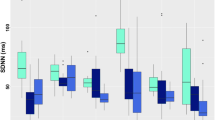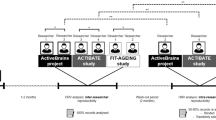Abstract
A growing trend among clinical studies is the use of heart rate monitors (HRMs) for assessment of heart rate variability (HRV). These instruments offer a convenient alternative to traditional electrocardiographs (ECGs) for recording and processing of R–R data. Reports on the validity of such systems are, however, conflicting. This study aimed to assess the validity of a commercial HRM on a large study sample, with emphasis on gender and age. Simultaneous recordings of R–R intervals were conducted with the Polar RS800 HRM and a 3-lead ECG on 341 individuals. Data editing was performed with individually designated software for each instrument. Agreement on SDNN, RMSSD, and HF- and LF power was assessed with intraclass correlations (ICCs), standard errors of measurement (SEMs) and Bland and Altman plots. The HRM was not able to identify 18 observations with non-sinus beats. For men, agreement between instruments ranged from good to excellent (ICC ≥ 0.8) on all HRV measures, and SEMs were generally small. For women the results were weaker, with unacceptable agreement between instruments on SDNN. Women over 60 years did not reach a critical ICC value of 0.75 on any of the HRV measures. Bland and Altman plots demonstrated that the RS800 generally overestimated HRV, and that uncertainty increased with higher values. Since the Polar system did not identify errors satisfactorily, or return valid values of HRV for certain groups, it is concluded that, whenever possible, traditional ECGs should be used for both gathering and editing of HRV data.

Similar content being viewed by others
References
Agelink MW, Boz C, Ullrich H, Andrich J (2002) Relationship between major depression and heart rate variability. Clinical consequences and implications for antidepressive treatment. Psychiatry Res 113(1–2):139–149
Arora R, Krummerman A, Vijayaraman P, Rosengarten M, Suryadevara V, Lejemtel T, Ferrick KJ (2004) Heart rate variability and diastolic heart failure. Pacing Clin Electrophysiol 27(3):299–303
Bar KJ, Boettger MK, Koschke M, Schulz S, Chokka P, Yeragani VK, Voss A (2007) Non-linear complexity measures of heart rate variability in acute schizophrenia. Clin Neurophysiol 118(9):2009–2015
Berkoff DJ, Cairns CB, Sanchez LD, Moorman CT 3rd (2007) Heart rate variability in elite American track-and-field athletes. J Strength Cond Res 21(1):227–231
Bland JM, Altman DG (1986) Statistical methods for assessing agreement between two methods of clinical measurement. Lancet 1(8476):307–310
Boettger S, Hoyer D, Falkenhahn K, Kaatz M, Yeragani VK, Bar KJ (2006) Altered diurnal autonomic variation and reduced vagal information flow in acute schizophrenia. Clin Neurophysiol 117(12):2715–2722
Boudet G, Chamoux A (2000) Heart rate monitors and abnormal heart rhythm detection. Arch Physiol Biochem 108(4):371–379
Correa PR, Catai AM, Takakura IT, Machado MN, Godoy MF (2010) [Heart rate variability and pulmonary infections after myocardial revascularization.]. Arq Bras Cardiol. doi:S0066-782X2010005000123
de Godoy MF, Takakura IT, Correa PR, Machado MN, Miranda RC, Brandi AC (2009) Preoperative nonlinear behavior in heart rate variability predicts morbidity and mortality after coronary artery bypass graft surgery. Med Sci Monit 15(3):CR117–CR122
Gamelin FX, Berthoin S, Bosquet L (2006) Validity of the polar S810 heart rate monitor to measure R–R intervals at rest. Med Sci Sports Exerc 38(5):887–893
Haji-Michael PG, Vincent JL, Degaute JP, van de Borne P (2000) Power spectral analysis of cardiovascular variability in critically ill neurosurgical patients. Crit Care Med 28(7):2578–2583
Henry BL, Minassian A, Paulus MP, Geyer MA, Perry W (2010) Heart rate variability in bipolar mania and schizophrenia. J Psychiatr Res 44(3):168–176
Hopkins WG (2000) Measures of reliability in sports medicine and science. Sports Med 30(1):1–15
Karason K, Molgaard H, Wikstrand J, Sjostrom L (1999) Heart rate variability in obesity and the effect of weight loss. Am J Cardiol 83(8):1242–1247
Kingsley M, Lewis MJ, Marson RE (2005) Comparison of Polar 810s and an ambulatory ECG system for RR interval measurement during progressive exercise. Int J Sports Med 26(1):39–44
Korach M, Sharshar T, Jarrin I, Fouillot JP, Raphael JC, Gajdos P, Annane D (2001) Cardiac variability in critically ill adults: influence of sepsis. Crit Care Med 29(7):1380–1385
La Rovere MT, Pinna GD, Maestri R, Mortara A, Capomolla S, Febo O, Ferrari R, Franchini M, Gnemmi M, Opasich C, Riccardi PG, Traversi E, Cobelli F (2003) Short-term heart rate variability strongly predicts sudden cardiac death in chronic heart failure patients. Circulation 107(4):565–570
Lee J, Koh D, Ong CN (1989) Statistical evaluation of agreement between two methods for measuring a quantitative variable. Comput Biol Med 19(1):61–70
Liao D, Cai J, Brancati FL, Folsom A, Barnes RW, Tyroler HA, Heiss G (1995) Association of vagal tone with serum insulin, glucose, and diabetes mellitus–the ARIC study. Diabetes Res Clin Pract 30(3):211–221
Liao D, Cai J, Barnes RW, Tyroler HA, Rautaharju P, Holme I, Heiss G (1996) Association of cardiac autonomic function and the development of hypertension: the ARIC study. Am J Hypertens 9(12 Pt 1):1147–1156
Loimaala A, Sievanen H, Laukkanen R, Parkka J, Vuori I, Huikuri H (1999) Accuracy of a novel real-time microprocessor QRS detector for heart rate variability assessment. Clin Physiol 19(1):84–88
Makikallio TH, Barthel P, Schneider R, Bauer A, Tapanainen JM, Tulppo MP, Schmidt G, Huikuri HV (2005) Prediction of sudden cardiac death after acute myocardial infarction: role of Holter monitoring in the modern treatment era. Eur Heart J 26(8):762–769
Malik M, Farrell T, Cripps T, Camm AJ (1989) Heart rate variability in relation to prognosis after myocardial infarction: selection of optimal processing techniques. Eur Heart J 10(12):1060–1074
Mestivier D, Chau NP, Chanudet X, Bauduceau B, Larroque P (1997) Relationship between diabetic autonomic dysfunction and heart rate variability assessed by recurrence plot. Am J Physiol 272(3 Pt 2):H1094–H1099
Miu AC, Heilman RM, Miclea M (2009) Reduced heart rate variability and vagal tone in anxiety: trait versus state, and the effects of autogenic training. Auton Neurosci 145(1–2):99–103
Nolan J, Batin PD, Andrews R, Lindsay SJ, Brooksby P, Mullen M, Baig W, Flapan AD, Cowley A, Prescott RJ, Neilson JM, Fox KA (1998) Prospective study of heart rate variability and mortality in chronic heart failure: results of the United Kingdom heart failure evaluation and assessment of risk trial (UK-heart). Circulation 98(15):1510–1516
Nunan D, Jakovljevic DG, Donovan G, Hodges LD, Sandercock GR, Brodie DA (2008) Levels of agreement for RR intervals and short-term heart rate variability obtained from the Polar S810 and an alternative system. Eur J Appl Physiol 103(5):529–537
Nunan D, Donovan G, Jakovljevic DG, Hodges LD, Sandercock GR, Brodie DA (2009) Validity and reliability of short-term heart-rate variability from the Polar S810. Med Sci Sports Exerc 41(1):243–250
Pinna GD, Maestri R, Torunski A, Danilowicz-Szymanowicz L, Szwoch M, La Rovere MT, Raczak G (2007) Heart rate variability measures: a fresh look at reliability. Clin Sci (Lond) 113(3):131–140
Porto LG, Junqueira LF Jr (2009) Comparison of time-domain short-term heart interval variability analysis using a wrist-worn heart rate monitor and the conventional electrocardiogram. Pacing Clin Electrophysiol 32(1):43–51
Rechlin T, Weis M, Spitzer A, Kaschka WP (1994) Are affective disorders associated with alterations of heart rate variability? J Affect Disord 32(4):271–275
Rodriguez-Colón SM, Bixler EO, Li X, Vgontzas AN, Liao D (2010) Obesity is associated with impaired cardiac autonomic modulation in children. Int J Pediatr Obes. doi:10.3109/17477166.2010.490265
Roy RA, Boucher JP, Comtois AS (2009) Heart rate variability modulation after manipulation in pain-free patients versus patients in pain. J Manipulative Physiol Ther 32(4):277–286
Ruha A, Sallinen S, Nissila S (1997) A real-time microprocessor QRS detector system with a 1-ms timing accuracy for the measurement of ambulatory HRV. IEEE Trans Biomed Eng 44(3):159–167
Santos-Hiss MD, Melo RC, Neves VR, Hiss FC, Verzola RM, Silva E, Borghi-Silva A, Porta A, Montano N, Catai AM (2010) Effects of progressive exercise during phase I cardiac rehabilitation on the heart rate variability of patients with acute myocardial infarction. Disabil Rehabil. doi:10.3109/09638288.2010.514016
Schroeder EB, Liao D, Chambless LE, Prineas RJ, Evans GW, Heiss G (2003) Hypertension, blood pressure, and heart rate variability: the Atherosclerosis Risk in Communities (ARIC) study. Hypertension 42(6):1106–1111
Singh JP, Larson MG, Tsuji H, Evans JC, O’Donnell CJ, Levy D (1998) Reduced heart rate variability and new-onset hypertension: insights into pathogenesis of hypertension: the Framingham Heart Study. Hypertension 32(2):293–297
Singh JP, Larson MG, O’Donnell CJ, Wilson PF, Tsuji H, Lloyd-Jones DM, Levy D (2000) Association of hyperglycemia with reduced heart rate variability (The Framingham Heart Study). Am J Cardiol 86(3):309–312
Storck N, Ericson M, Lindblad L, Jensen-Urstad M (2001) Automatic computerized analysis of heart rate variability with digital filtering of ectopic beats. Clin Physiol 21(1):15–24
Task Force (1996) Heart rate variability. Standards of measurement, physiological interpretation, and clinical use. Task Force of the European Society of Cardiology and the North American Society of Pacing and Electrophysiology. Eur Heart J 17(3):354–381
Weippert M, Kumar M, Kreuzfeld S, Arndt D, Rieger A, Stoll R (2010) Comparison of three mobile devices for measuring R–R intervals and heart rate variability: Polar S810i, Suunto t6 and an ambulatory ECG system. Eur J Appl Physiol 109(4):779–786
Weir JP (2005) Quantifying test–retest reliability using the intraclass correlation coefficient and the SEM. J Strength Cond Res 19(1):231–240
Yeragani VK, Sobolewski E, Igel G, Johnson C, Jampala VC, Kay J, Hillman N, Yeragani S, Vempati S (1998) Decreased heart-period variability in patients with panic disorder: a study of Holter ECG records. Psychiatry Res 78(1–2):89–99
Acknowledgments
The authors wish to thank Karolinska Institutet, the FAS-center for research on hearing loss in working life, Tysta Skolan, and the Swedish Medical Research Council for their financial support. We also wish to express our gratitude to Peter Friberg and Gun Bodehed Berg for highly valuable technical advice. We also wish to thank the participants of the SLOSH study and the entire technical staff involved in the project: Agneta Viberg, Susanna Benka. Moreover, we are grateful to Mats Ericson for his expertise in the planning of this study, as well as to Polar Electro Sverige AB (Bromma, Sweden) for supplying the RS800 HRM. Special thanks are extended to Mahsa Pourheidari and Daniel Zand at Avesina Hörselrehab, who provided their clinical facilities and equipment for this study.
Conflict of interest
We declare that we have no conflict of interest or competing interest. The study was funded by Karolinska Institutet, the FAS-center for research on hearing loss in working life, Tysta Skolan, and the Swedish Medical Research Council. The funders have no financial interest in the research that they support.
Author information
Authors and Affiliations
Corresponding author
Additional information
Communicated by Susan A. Ward.
Rights and permissions
About this article
Cite this article
Wallén, M.B., Hasson, D., Theorell, T. et al. Possibilities and limitations of the polar RS800 in measuring heart rate variability at rest. Eur J Appl Physiol 112, 1153–1165 (2012). https://doi.org/10.1007/s00421-011-2079-9
Received:
Accepted:
Published:
Issue Date:
DOI: https://doi.org/10.1007/s00421-011-2079-9




